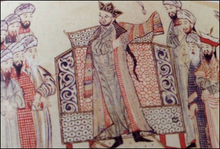Artuk Bey
Zaheer-ul-Daulah Artuk Beg, known as Artuk Bey, was a Turkish commander of the Seljuk Empire in the 11th century. His father's name was Eksük. He was the Seljuk governor of Jerusalem between 1085–1091. Although the Artuqid dynasty was named after him, actually the dynasty was founded 11 years after his death by his sons Sökmen and Ilghazi. He was also father to Alp-Yaruq, Bahram, Abd al-Jabar, and three other sons.[2]
Zaheer-ul-Daulah Artuk Beg | |
|---|---|
 | |
| Governor of Jerusalem | |
| In office 1085–1091 | |
| Succeeded by | Ilghazi and Sökmen |
| Personal details | |
| Born | unknown |
| Died | 1091 Jerusalem, Seljuk Empire |
| Nationality | Turk, Döger tribe of the Oghuz[1] |
| Military service | |
| Allegiance | Seljuk Empire |
| Rank | General |
| Battles/wars | Battle of Manzikert (1071) Conquest of Amid (1085) Battle of Aleppo (1086) |
In Anatolia
Artuk Bey was one of the commanders of the Great Seljuk Empire army during the Battle of Manzikert in 1071. After the battle, he took part in the conquest of Anatolia on behalf of the Seljuk Empire. He captured the Yeşilırmak valley in 1074. He also served the sultan by quashing a rebellion in 1077.[3]
His next mission was a campaign in 1086 to capture Diyarbakır (Amid) from the Marwanids. In this campaign he quarreled with the commander-in-chief Fakhr al-Dawla ibn Jahir who tended to make peace with Marwanids. In a surprise attack he defeated reinforcements to Marwanids. However, when the sultan Malik Shah I heard about the event he accused Artuk.[4]
In Syria
Artuk left the battle field and attended to Tutush I who was Malik Shah's discordant younger brother in Syria in 1084. In 1086 he was instrumental in defeating Suleiman ibn Qutulmish, the sultan of Seljuks of Rûm in a battle between Süleyman and Tutush.
In Jerusalem
Tutush granted him al-Quds (Jerusalem) as an iqta and Artuk was governor there until his death in 1091. His grave is in a tomb next to his khanqah near the Gate of al-Dawadariya, known as Gate of King Faisal today.
Citation
- "İslâm Ansiklopedisi Online (in Turkish)" PDF "TDV Encyclopedia of Islam" Archived 2014-11-10 at the Wayback Machine. Retrieved 25 March 2015
- Hillenbrand, Carole, History of the Jazira, 1100-1150: The Contribution of ibn al-Azraq al-Fariqi, Ph.D. thesis, University of Edinburgh, 1979, pg. 620
- Yüce- Sevim p.164
- Yüce-Sevim, p.68
Sources
- Yücel, Yaşar; Sevim, Ali (1990). Türkiye Tarihi Cilt I. Ankara: AKDTYK Yayınları.